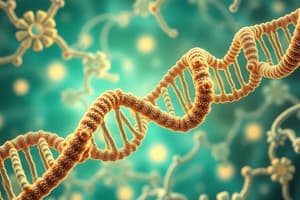Podcast
Questions and Answers
What contributes to the positive charge on histones?
What contributes to the positive charge on histones?
- Arginine (correct)
- Serine
- Aspartic acid
- Cysteine
How many base pairs are typically found in a nucleosome?
How many base pairs are typically found in a nucleosome?
- 500
- 200
- 300
- 147 (correct)
Which statement about nucleosomes is true?
Which statement about nucleosomes is true?
- DNA is wrapped around histone proteins. (correct)
- They have a positive charge overall.
- Histones are negatively charged proteins.
- They consist of RNA and DNA complexes.
Which of the following statements about heterochromatin is false?
Which of the following statements about heterochromatin is false?
What is the relationship between the charges of histones and DNA?
What is the relationship between the charges of histones and DNA?
Flashcards are hidden until you start studying
Study Notes
Histone Charges
- Histones are proteins associated with DNA in chromatin, contributing to the structural organization of genetic material.
- The positive charge on histones primarily arises from the presence of amino acids, specifically arginine and lysine, due to their basic side chains.
Nucleosome Structure
- A nucleosome consists of approximately 200 base pairs (bp) of DNA wrapped around a core of histone proteins.
- This structure forms the fundamental unit of chromatin, playing a crucial role in packaging DNA within the nucleus.
Assertion & Reason Concepts
- An assertion regarding nucleosome charge states that the net charge is neutral—this is true due to oppositely charged components: histones (positively charged) and DNA (negatively charged).
- There is a distinction between the attributes of heterochromatin and euchromatin, where heterochromatin is conventionally considered transcriptionally inactive due to its tightly packed state.
Heterochromatin vs. Euchromatin
- Heterochromatin is characterized by dense packing, resulting in reduced transcriptional activity compared to euchromatin, which is loosely packed and transcriptionally active.
- Misconceptions exist regarding the transcriptional state of heterochromatin, as it is not active despite some being loosely packed under certain conditions.
Studying That Suits You
Use AI to generate personalized quizzes and flashcards to suit your learning preferences.




